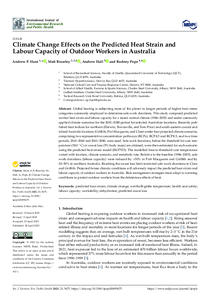Climate change effects on the predicted heat strain and labour capacity of outdoor workers in Australia

Hunt, Andrew P. ; Brearley, Matt ; Hall, Andrew ; Pope, Rodney
International Journal of Environmental Research and Public Health
2023
20
9
5675
climate change ; outdoor work ; extreme temperatures ; heat stress assessment ; work capacity ; plant safety and health organization
Occupational risks
https://doi.org/10.3390/ijerph20095675
English
Bibliogr.
"Global heating is subjecting more of the planet to longer periods of higher heat stress categories commonly employed to determine safe work durations. This study compared predicted worker heat strain and labour capacity for a recent normal climate (1986-2005) and under commonly applied climate scenarios for the 2041-2080 period for selected Australian locations. Recently published heat indices for northern (Darwin, Townsville, and Tom Price) and south-eastern coastal and inland Australia locations (Griffith, Port Macquarie, and Clare) under four projected climate scenarios, comprising two representative concentration pathways (RCPs), RCP4.5 and RCP8.5, and two time periods, 2041-2060 and 2061-2080, were used. Safe work durations, before the threshold for core temperature (38.0 °C) or sweat loss (5% body mass) are attained, were then estimated for each scenario using the predicted heat strain model (ISO7933). The modelled time to threshold core temperature varied with location, climate scenario, and metabolic rate. Relative to the baseline (1986-2005), safe work durations (labour capacity) were reduced by >50% in Port Macquarie and Griffith and by 20-50% in northern Australia. Reaching the sweat loss limit restricted safe work durations in Clare and Griffith. Projected future climatic conditions will adversely impact the predicted heat strain and labour capacity of outdoor workers in Australia. Risk management strategies must adapt to warming conditions to protect outdoor workers from the deleterious effects of heat."
Digital
The ETUI is co-funded by the European Union. Views and opinions expressed are however those of the author(s) only and do not necessarily reflect those of the European Union or the ETUI.